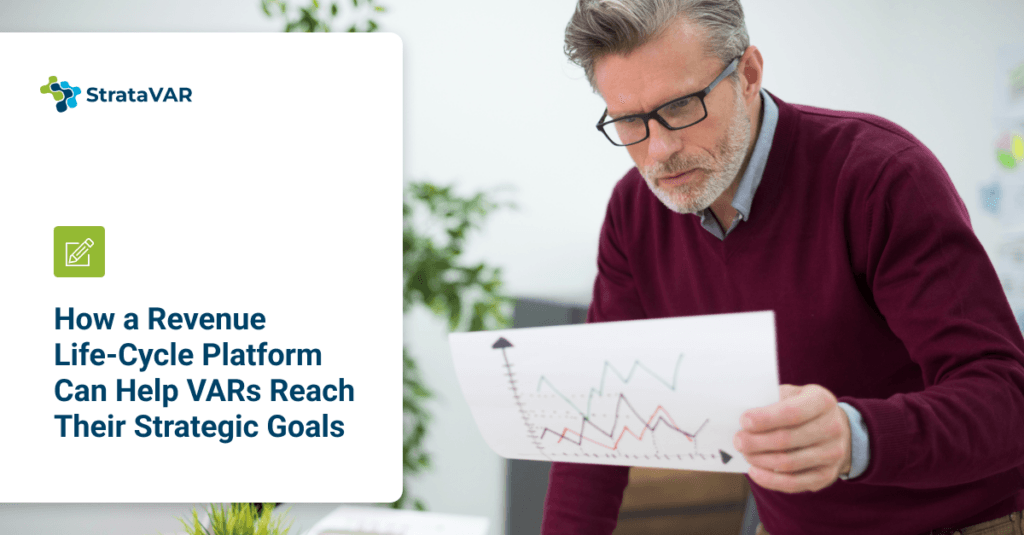
In the ICT industry, Value-Added Resellers (VARs) encounter diverse challenges that span multiple functions. For CEOs, overcoming these hurdles requires prioritizing key strategic goals: boosting revenue, fostering sustainable growth, aligning with evolving customer needs, and creating a future-ready organization.
Some VARs are adopting a managed services model, shifting from one-time transactions to providing ongoing business solutions. The appeal of this emerging approach lies in its ability to generate recurring revenue streams and foster stronger, long-term client relationships.
A revenue lifecycle platform is designed to streamline and automate key revenue-related processes across the organization. By handling tasks such as quoting, pricing, renewals, and vendor management, this type of platform reduces manual work and improves accuracy, allowing teams to operate more efficiently. By integrating workflows and providing real-time data, it enables teams to work efficiently across the entire revenue journey—from initial quotes to recurring renewals—boosting customer satisfaction and driving profitability.
This article explores how a revenue lifecycle platform helps VARs tackle common ICT VAR challenges and achieve their goals by enhancing finance, operations, IT, and customer success functions, creating a unified and results-driven approach.
CEOs in the ICT space often share a set of top-level goals that drive organizational direction. Strategic goals for VARs typically include:
For finance teams, a revenue lifecycle platform for VARs streamlines financial management by automating revenue processes, cutting costs, and delivering real-time insights. This enables finance leaders to make informed budgeting decisions, boost ROI, and improve profit margins.
A crucial element in optimizing financial operations is seamless ERP integration, synchronizing data points like invoicing, inventory, and reporting across departments. This reduces errors and enhances transparency, creating a more reliable financial foundation. Understanding the ROI of Implementing Automated Quoting Solutions is key for finance teams.
Additionally, by consolidating quotes and renewal information in one place, the platform enables more effective forecasting of both prospect pipelines and renewals, allowing finance teams to predict revenue streams with greater precision.
We often hear from managers in multi-currency transactions VARs that working with real-time transactions in multiple currencies poses a challenge. A revenue lifecycle platform with capabilities like seamless global transactions and real-time currency updates minimizes errors and ensures accuracy. This is just one example of how the right platform can tackle complex financial challenges and streamline operations.
How does the platform align with financial targets for cost efficiency and ROI?
In what ways does automated reporting enhance visibility and control over revenue processes?
How can improved forecasting tools support better financial planning and decision-making?
For operations teams, a revenue lifecycle platform simplifies quote-to-cash processes, reduces bottlenecks and enhances workflow accuracy. By streamlining quotes and enabling rapid, intelligent parsing of supplier files, it minimizes manual, repetitive tasks. This revenue cycle optimization allows operations teams to focus on higher-value work, driving operational excellence that aligns with CEO-level growth and efficiency goals.Key Insights from Our Clients
VARs consistently mention that high-volume quoting, especially for complex configurations, can be a roadblock. A revenue lifecycle platform supports quotes with up to 50K line items, enabling faster, more accurate quoting for even the most complex sales structures.
Which processes create the biggest bottlenecks in the revenue cycle, and how does automation alleviate them?
How does supporting large-scale quotes directly contribute to operational efficiency and customer satisfaction?
For IT teams, scalability and integration are essential for innovation and future-proofing. A revenue lifecycle platform streamlines digital transformation by integrating with systems, managing high data volumes, and ensuring security, positioning VARs to scale with technological advancements.
IT leaders frequently emphasize the importance of managing integrations not only with multiple vendors and distributors but also with critical internal systems like CRM, ERP, and other third-party tools. Advanced API integrations ensure that VARs have real-time access to comprehensive data across platforms, reducing manual data handling and boosting overall system efficiency.
How does the platform support our organization’s digital transformation and scalability needs?
What security measures are in place to ensure data integrity and compliance across transactions?
For customer success teams, the focus is on maintaining high levels of client satisfaction and ensuring seamless renewals. A revenue lifecycle platform enhances VAR customer success strategies by providing streamlined quoting, real-time tracking of vendor rebates, and proactive renewal management—including End-of-Life (EoX) notifications.
We frequently hear that staying ahead of renewals and ensuring clients are aware of end-of-life products present a challenge. The platform not only automates these notifications but also offers renewal management capabilities, helping customer success teams stay proactive and responsive.
How can enhanced quoting and tracking help our teams deliver better customer service?
What metrics can we use to assess customer satisfaction and renewal rates linked to improved service delivery?
To fully leverage a revenue lifecycle platform, CEOs and their teams should consider the following best practices to ensure alignment with strategic goals:
A revenue lifecycle platform tailored for VARs is a strategic investment that drives VAR innovation and scalability by aligning revenue processes across finance, operations, IT, and customer success. By streamlining the quote-to-cash cycle and addressing department-specific needs, VARs can enhance efficiency, improve customer satisfaction, and stay competitive amidst evolving ICT industry trends for VARs.
For VARs focused on future-proofing operations and achieving sustainable growth, adopting a holistic revenue lifecycle approach is essential. This strategy enables them to overcome challenges, align cross-departmental efforts, and secure long-term success in the dynamic ICT landscape.

Salesforce™, Force.com™ and other trademarks are trademarks of Salesforce.com, Inc. and are used here with permission.
2024© All rights reserved
Made with 🤍 by StrataVAR